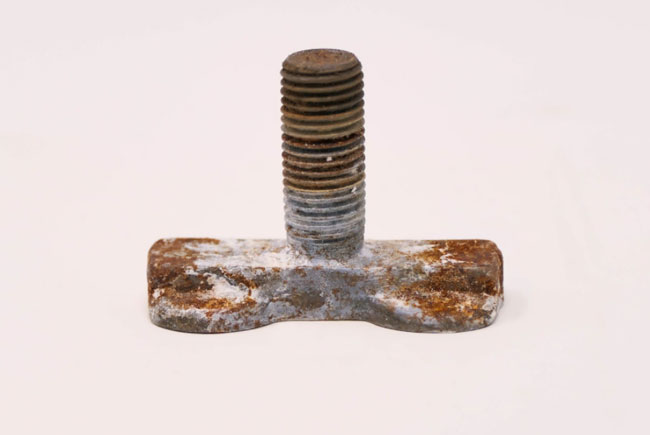In previous articles, we outlined principles of the corrosive process,
plus the causes and the most common treatment plans. At this point, you have an
understanding of the oxidation chemistry that induces corrosive attacks and the
risk factors that stem from moisture and pollutants. Now, it is important to
understand the different types of corrosion that can occur on your aircraft.
The different types of corrosion can be broken down according to the affected area
and the time frame. Degradation of the metal can either occur over a large area (a
situation called uniform corrosion) or over a small area (localized corrosion). Similarly,
corrosion can be time-dependent, cycle-dependent, or time-independent. Time-dependent
corrosion proceeds at a predictable rate when the factors that create it are consistently
present. Cycle-dependent corrosion primarily occurs in proportion with its repeated exposure
to the contributing factor. Time-independent corrosion does not correlate to the length
of time of exposure.

Seat Track Fitting
This article will give you a detailed breakdown of each type of corrosion as a key consideration
in the design, manufacture, and maintenance of aircraft. Our objective is to help
prepare you to prevent corrosive attacks by understanding the different types of corrosive
processes, therefore limiting the susceptibility of your specific equipment.
1. Time-dependent & Cycle-dependent Corrosion
Time-dependent and cycle-dependent corrosion are associated with a slow degradation of equipment.
Both require a significant amount of time to elapse before they become harmful. The most common
subcategories are as follows:
- Galvanic corrosion begins when two dissimilar metal surfaces abut each other. Due to the
presence of an electrolyte and the potential difference in voltage between the two,
oxidation and the associated corrosion occurs more quickly. Of course, the longer the
conditions between the two metals persist, the more the corrosion advances.
- Uniform corrosion happens when a metal surface is consistently eroded, typically on the outer
surface and underbelly of the aircraft. This can occur because of weathering or from exposure
to certain types of pollution. This can also occur in the airplane's interior after a spill
occurs with a large amount of fluid. Many liquids accelerate the oxidative process. The best
prevention for this type of corrosion is proper pretreatment, protective coating, and detailed
maintenance to find and remove leakage and spillage when it happens.
- Crevice corrosion is the most frequent subtype found in aircraft. The chemistry behind it is
similar to galvanic corrosion, except dissimilar environmental conditions are the root cause
instead of dissimilar metals. For example, differences in humidity or oxygen concentration will
cause the metal to degrade. This type of corrosion is notoriously difficult to deal with because
it typically begins in small, hidden areas. Fortunately, it can be mitigated by the careful
application of a sealant.
- Pitting-type corrosion can be recognized by its appearance: the metal surface will begin to
dull and look dusty. When this debris is removed, small holes become apparent and are usually
localized. As time passes, the pits will increase in size and allow for more chemicals and moisture
to be trapped. This normally results from a lack of protective coating in a small area and can be
prevented by quality control during paint treatment plus continued inspection.
- Fretting is the result of two different effects - surface weathering and cell corrosion - and occurs
through the same electrochemical process as galvanic corrosion. As the metal surface is worn down,
the exposed metal begins to fall off in pieces. This process requires specific conditions of high
pressure or movement which allows the wear to occur and provides a pathway for moisture to be trapped
on the surface of the substrate. Fretting can sometimes occur between fuel panels and the aircraft
structure. Preventing this is complicated and must be addressed during the design phase by making
sure contact points are thoroughly sealed and buffered. Hard surfaces should be placed in contact with
softer ones to minimize the abrasive aspect of this corrosive process.

Corrosion on structure beam
2. Time-independent Corrosion
Time-independent corrosion arises infrequently and has two subtypes:
- Stress corrosion cracking is induced by stress from constant tension combined
with oxidative corrosion which causes the metal surface to crack. This risk is increased
during the manufacturing phase by small deformations in equipment, temperature changes,
and engineering that shifts volume distribution. When these small contributions are present,
the added weight of operating the airplane exponentially increases the total tension and
stress which, in turn, causes damage. Furthermore, this is expedited by moist, humid
environments and saltwater which then penetrates the cracks and causes an additional
corrosive attack. The best way to combat this is through very careful industrial design
with an emphasis on eliminating stress in contact points and joints.
- Embrittlement is a type of corrosion that occurs due to hydrogen reactions instead
of oxidation ones. Hydrogen frequently accumulates in metal as it can travel past the
surface and react with other elements to form hydrides that corrode metal. It creates
holes and cracks within equipment layers. The only way to prevent this type of corrosion
is to select metal alloys, such as nickel, which do not chemically accumulate hydrogen.
Conclusion
The various types of corrosion pose many risks for damage to aircraft and must be considered carefully.
Keeping these in mind when designing, manufacturing, and maintaining your aircraft will extend
its lifetime and decrease repair costs significantly.
Now that you understand the different types of corrosion, you will be able to properly select which
Av-DEC product is best for your unique purpose. To learn more, contact an
Av-DEC representative
today.

